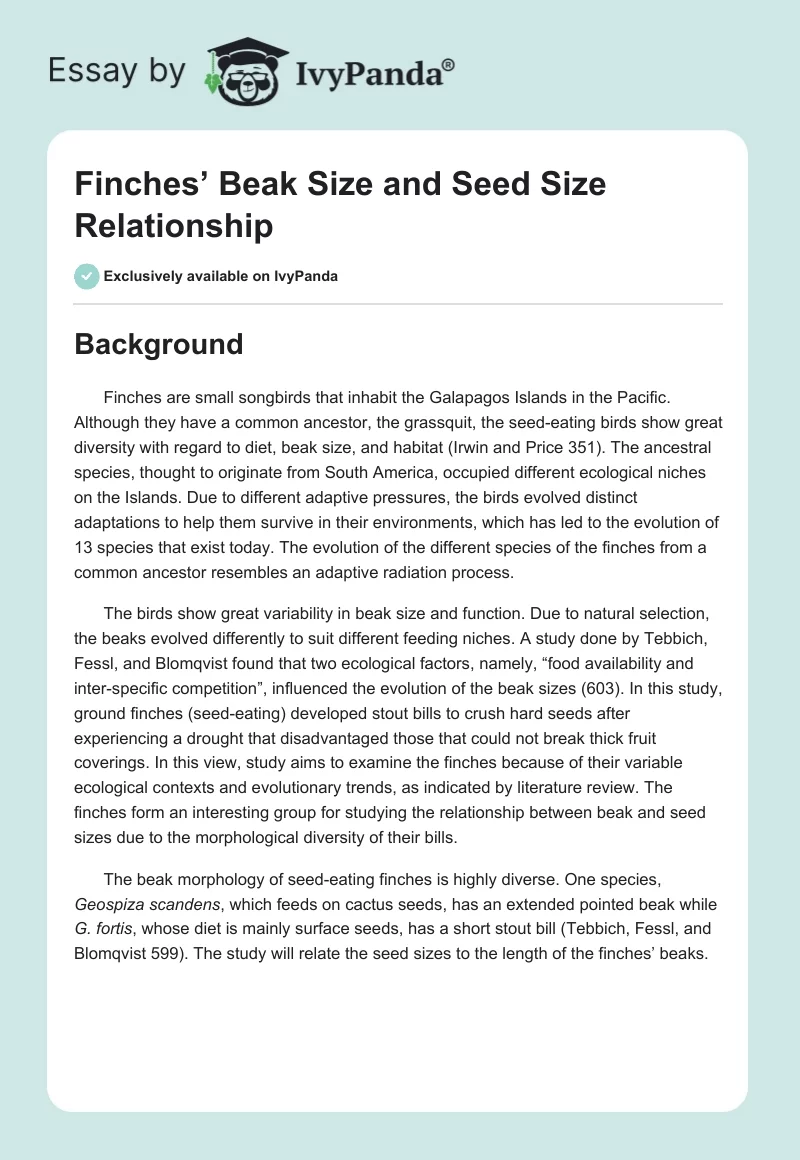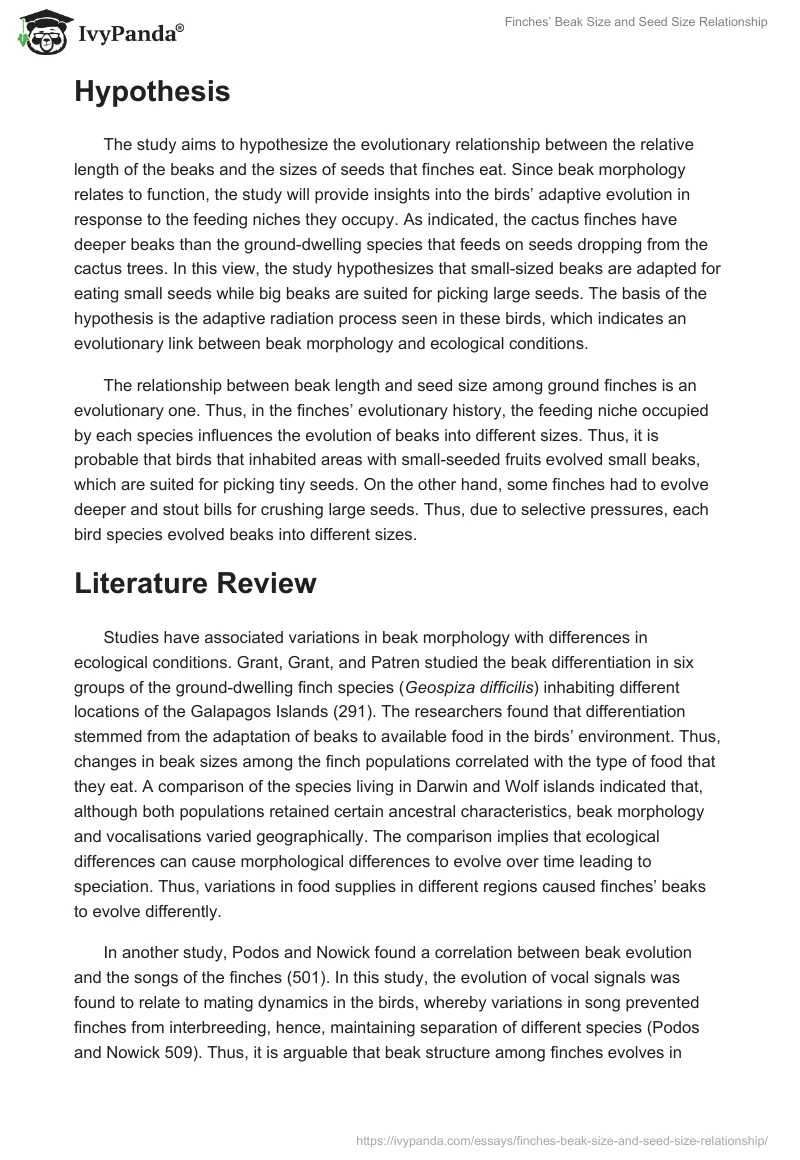Background
Finches are small songbirds that inhabit the Galapagos Islands in the Pacific. Although they have a common ancestor, the grassquit, the seed-eating birds show great diversity with regard to diet, beak size, and habitat (Irwin and Price 351). The ancestral species, thought to originate from South America, occupied different ecological niches on the Islands. Due to different adaptive pressures, the birds evolved distinct adaptations to help them survive in their environments, which has led to the evolution of 13 species that exist today. The evolution of the different species of the finches from a common ancestor resembles an adaptive radiation process.
The birds show great variability in beak size and function. Due to natural selection, the beaks evolved differently to suit different feeding niches. A study done by Tebbich, Fessl, and Blomqvist found that two ecological factors, namely, “food availability and inter-specific competition”, influenced the evolution of the beak sizes (603). In this study, ground finches (seed-eating) developed stout bills to crush hard seeds after experiencing a drought that disadvantaged those that could not break thick fruit coverings. In this view, study aims to examine the finches because of their variable ecological contexts and evolutionary trends, as indicated by literature review. The finches form an interesting group for studying the relationship between beak and seed sizes due to the morphological diversity of their bills.
The beak morphology of seed-eating finches is highly diverse. One species, Geospiza scandens, which feeds on cactus seeds, has an extended pointed beak while G. fortis, whose diet is mainly surface seeds, has a short stout bill (Tebbich, Fessl, and Blomqvist 599). The study will relate the seed sizes to the length of the finches’ beaks.
Hypothesis
The study aims to hypothesize the evolutionary relationship between the relative length of the beaks and the sizes of seeds that finches eat. Since beak morphology relates to function, the study will provide insights into the birds’ adaptive evolution in response to the feeding niches they occupy. As indicated, the cactus finches have deeper beaks than the ground-dwelling species that feeds on seeds dropping from the cactus trees. In this view, the study hypothesizes that small-sized beaks are adapted for eating small seeds while big beaks are suited for picking large seeds. The basis of the hypothesis is the adaptive radiation process seen in these birds, which indicates an evolutionary link between beak morphology and ecological conditions.
The relationship between beak length and seed size among ground finches is an evolutionary one. Thus, in the finches’ evolutionary history, the feeding niche occupied by each species influences the evolution of beaks into different sizes. Thus, it is probable that birds that inhabited areas with small-seeded fruits evolved small beaks, which are suited for picking tiny seeds. On the other hand, some finches had to evolve deeper and stout bills for crushing large seeds. Thus, due to selective pressures, each bird species evolved beaks into different sizes.
Literature Review
Studies have associated variations in beak morphology with differences in ecological conditions. Grant, Grant, and Patren studied the beak differentiation in six groups of the ground-dwelling finch species (Geospiza difficilis) inhabiting different locations of the Galapagos Islands (291). The researchers found that differentiation stemmed from the adaptation of beaks to available food in the birds’ environment. Thus, changes in beak sizes among the finch populations correlated with the type of food that they eat. A comparison of the species living in Darwin and Wolf islands indicated that, although both populations retained certain ancestral characteristics, beak morphology and vocalisations varied geographically. The comparison implies that ecological differences can cause morphological differences to evolve over time leading to speciation. Thus, variations in food supplies in different regions caused finches’ beaks to evolve differently.
In another study, Podos and Nowick found a correlation between beak evolution and the songs of the finches (501). In this study, the evolution of vocal signals was found to relate to mating dynamics in the birds, whereby variations in song prevented finches from interbreeding, hence, maintaining separation of different species (Podos and Nowick 509). Thus, it is arguable that beak structure among finches evolves in accordance with the prevailing ecological conditions. Natural selection plays a role in determining the beak morphology and function in different populations. Tebbich, Sterelny, and Teschke posit that ancestral finches, compared to other species in the Galapagos, had greater adaptability that enabled them to thrive in many environments and exploit different food resources (143). The adaption allowed them to evolve and acquire new foraging methods. Thus, their beak sizes and shapes developed based on the type of food consumed by the individual birds.
The type of food consumed led to the morphological differentiation in the birds. Therefore, when different bird populations constructed distinct niches, they evolved differently. They responded to the ecological conditions in a way that led to evolutionary changes (Laland 582). Thus, as the birds developed different foraging techniques, natural selection played a role in bringing about genetic changes that made the finches efficient in their feeding niche. The evolution mechanism indicates that beak morphology co-evolved with the birds’ feeding behaviour in their environments (Bateson 285). The differences in beak sizes indicate that the birds responded differently to their habitats and food types in the environment. In light of this, the present study will examine the relationship between the length of the beaks and the sizes of seeds that seed-eating finches eat.
Laboratory Experiment
Introduction
A lab experiment will be done to test the study’s hypothesis. Five different locations on the islands that the birds inhabit will be marked. Ground-dwelling finches with different beak sizes will be obtained from these locations. A sample of six birds, whose beak sizes fall within the small, medium, and large categories, will be sufficient for this experiment. The experiment will also require cactus seeds of different sizes. The aim of the study will be to determine the number of seeds in each category that the finches will eat within a given time.
Set up
In the first experiment, the birds will be separated into three groups, namely, small, medium, and large, and put them in different cages. The beak sizes will be measured in each category and an average length obtained. Each bird will be caged separately to avoid the effects of competition.
Cactus seeds will be sorted into three groups, namely, small, medium, and large seeds.
For each category of birds, the seeds will be distributed as follows:
- Give 10 small seeds to the small-, medium-, and large-beaked birds on day 1.
- Give 10 medium seeds to the small-, medium-, and large-beaked birds on day 2.
- Give 10 large seeds to the small-, medium-, and large-beaked birds on day 3.
The number of seed in each size that the individual bird category consumes in a ten-minute period will be recorded. The experiment (seed size) will be repeated on different days to ensure that the bird’s gratification does not influence their ability to eat the seeds.
In the second experiment, researcher will cage small-beaked and large-beaked birds together and give them a mixture of small and large seeds. Researcher will then record the number of seeds (small and large) that each bird category consumes in a ten-minute period. It is expected that the birds will prefer different seeds depending on their beak size.
The study will make conclusions based on the number of seeds that birds with large beaks consume compared to amount eaten by those with small beaks. Due to beak-size limitation, finches with small beaks may not be able to eat large seeds. In the second experiment, competition is introduced to highlight the behavioural differences that drive evolutionary changes (Tebbich, Fessl, and Blomqvist 602). Large-beaked birds, though able to pick tiny seeds, often prefer large seeds to small ones. It is only after finishing the large seeds that the large-beaked birds feed on the smaller ones. The study will indicate how beak size relates to the sizes of seeds that finches eat. The general sketch of the experiment is shown in the figure below.

Works Cited
Bateson, Patrick. “The active role of behaviour in evolution.” Biological Philosophy 19.1 (2004): 283-298. Print.
Grant, Peter, Rosemary Grant, and Kenneth Petren. “The allopatric phase of speciation: The sharp-beaked ground finch (Geospiza difficilis) on the Galápagos Islands.” Biological Journal of the Linnaean Society 69 (2000): 287-317. Print.
Irwin, Darren and Trevor Price. “Sexual imprinting, learning and speciation.” Heredity 82 (1999): 347-354. Print.
Laland, Kevin. “Exploring gene–culture interactions: insights from handedness, sexual selection and niche-construction case studies.” Philosophical Transactions B 363 (2008): 577-589. Print.
Podos, Jeffrey and Stephen Nowick. “Beaks: Adaptation, and Vocal Evolution in Darwin’s Finches.” Bioscience 54.6 (2004): 501-510. Print.
Tebbich, Sabine, Birgit Fessl, and Donald Blomqvist. “Exploration and ecology in Darwin’s finches.” Ecological Evolution 23.1 (2009): 595-605. Print.
Tebbich, Sabine, Kim Sterelny, and Irmgard Teschke. “The tale of the finch: adaptive radiation and behavioural flexibility.” Philosophical Transactions B 370.6 (2010): 141-154. Print.


